Leadership And Employee Involvement
VerifiedAdded on 2022/08/08
|10
|2749
|34
AI Summary
10 annotated bibliographies from any topic 1-4 please see attached file
Contribute Materials
Your contribution can guide someone’s learning journey. Share your
documents today.
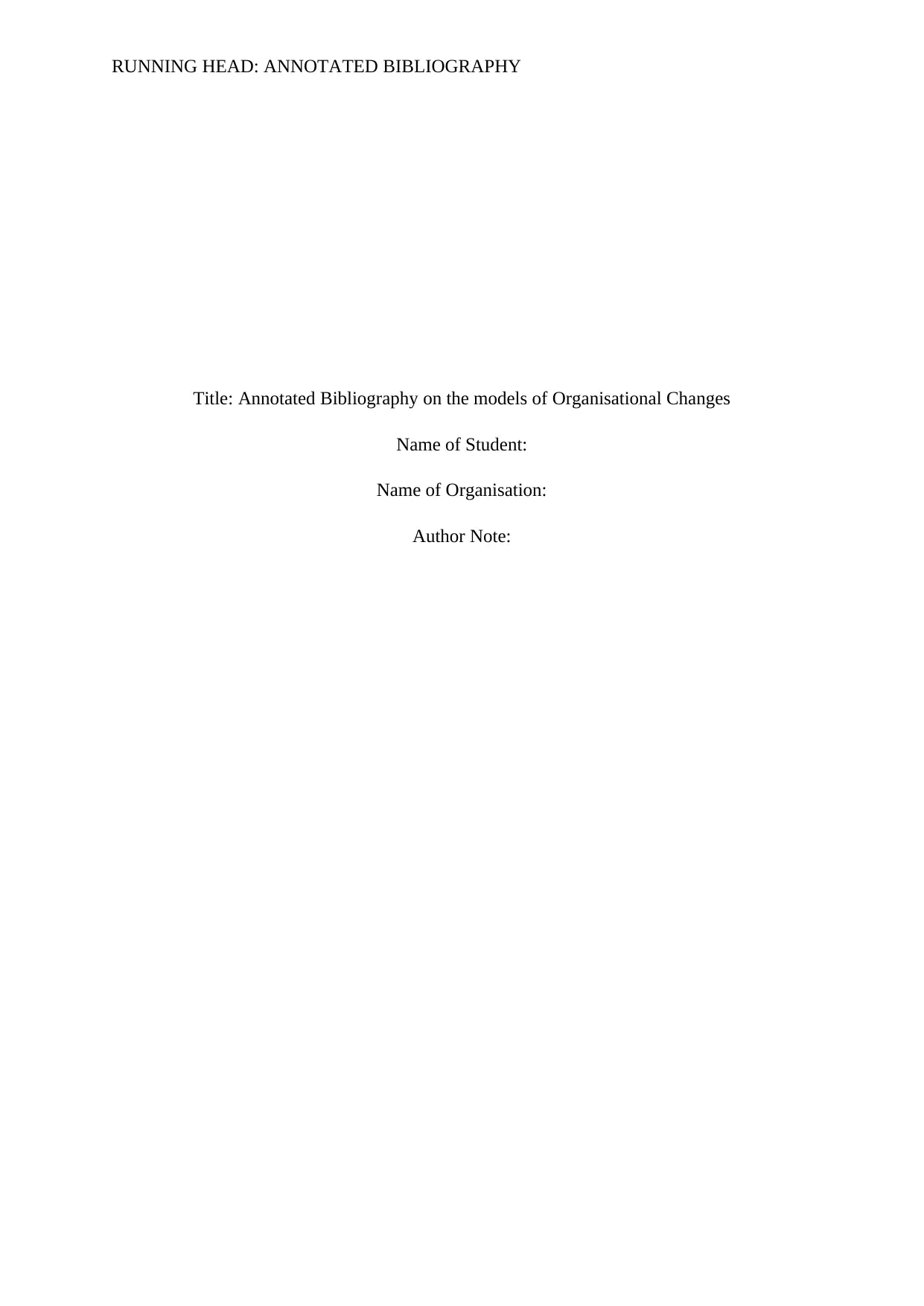
RUNNING HEAD: ANNOTATED BIBLIOGRAPHY
Title: Annotated Bibliography on the models of Organisational Changes
Name of Student:
Name of Organisation:
Author Note:
Title: Annotated Bibliography on the models of Organisational Changes
Name of Student:
Name of Organisation:
Author Note:
Secure Best Marks with AI Grader
Need help grading? Try our AI Grader for instant feedback on your assignments.
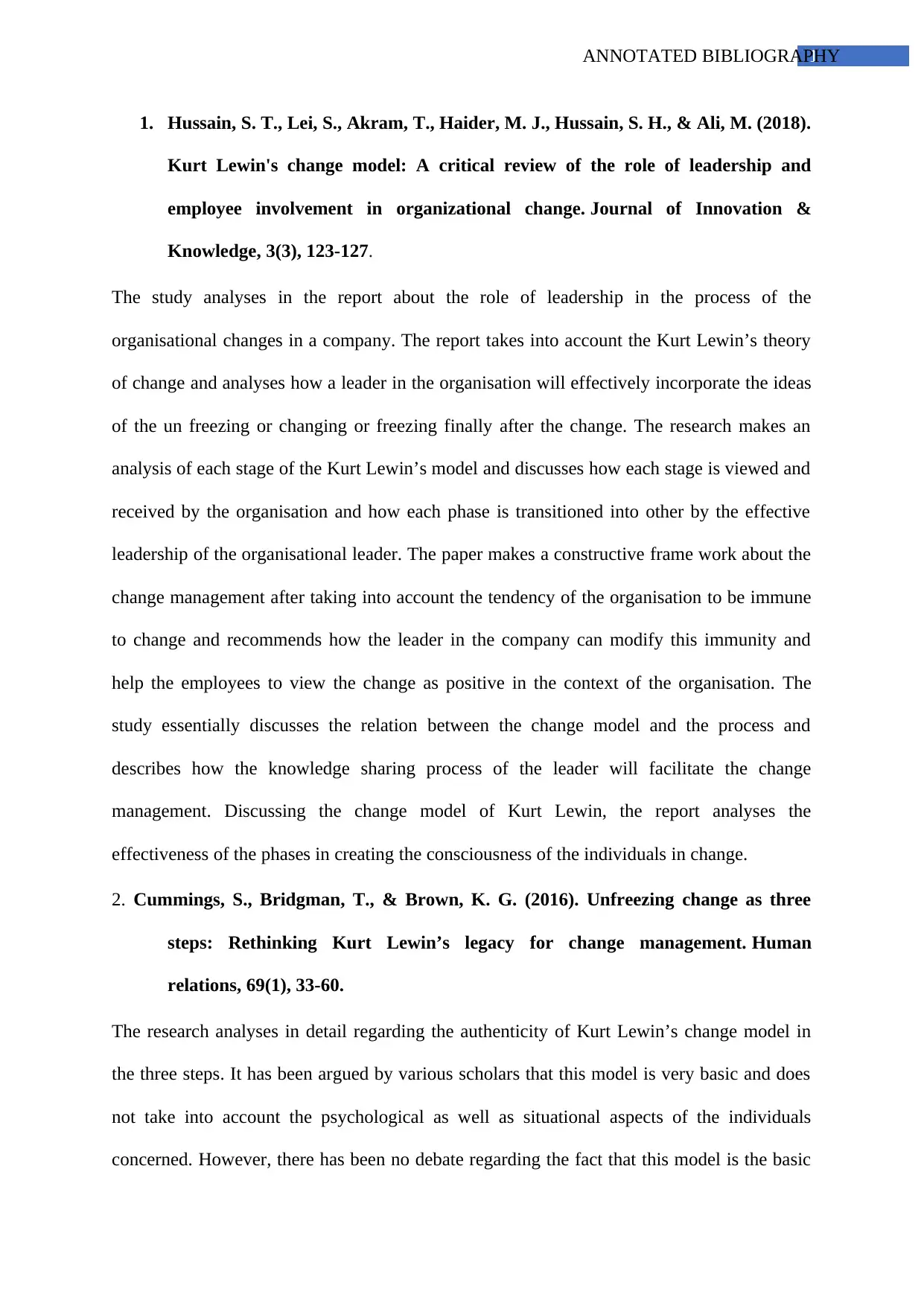
1ANNOTATED BIBLIOGRAPHY
1. Hussain, S. T., Lei, S., Akram, T., Haider, M. J., Hussain, S. H., & Ali, M. (2018).
Kurt Lewin's change model: A critical review of the role of leadership and
employee involvement in organizational change. Journal of Innovation &
Knowledge, 3(3), 123-127.
The study analyses in the report about the role of leadership in the process of the
organisational changes in a company. The report takes into account the Kurt Lewin’s theory
of change and analyses how a leader in the organisation will effectively incorporate the ideas
of the un freezing or changing or freezing finally after the change. The research makes an
analysis of each stage of the Kurt Lewin’s model and discusses how each stage is viewed and
received by the organisation and how each phase is transitioned into other by the effective
leadership of the organisational leader. The paper makes a constructive frame work about the
change management after taking into account the tendency of the organisation to be immune
to change and recommends how the leader in the company can modify this immunity and
help the employees to view the change as positive in the context of the organisation. The
study essentially discusses the relation between the change model and the process and
describes how the knowledge sharing process of the leader will facilitate the change
management. Discussing the change model of Kurt Lewin, the report analyses the
effectiveness of the phases in creating the consciousness of the individuals in change.
2. Cummings, S., Bridgman, T., & Brown, K. G. (2016). Unfreezing change as three
steps: Rethinking Kurt Lewin’s legacy for change management. Human
relations, 69(1), 33-60.
The research analyses in detail regarding the authenticity of Kurt Lewin’s change model in
the three steps. It has been argued by various scholars that this model is very basic and does
not take into account the psychological as well as situational aspects of the individuals
concerned. However, there has been no debate regarding the fact that this model is the basic
1. Hussain, S. T., Lei, S., Akram, T., Haider, M. J., Hussain, S. H., & Ali, M. (2018).
Kurt Lewin's change model: A critical review of the role of leadership and
employee involvement in organizational change. Journal of Innovation &
Knowledge, 3(3), 123-127.
The study analyses in the report about the role of leadership in the process of the
organisational changes in a company. The report takes into account the Kurt Lewin’s theory
of change and analyses how a leader in the organisation will effectively incorporate the ideas
of the un freezing or changing or freezing finally after the change. The research makes an
analysis of each stage of the Kurt Lewin’s model and discusses how each stage is viewed and
received by the organisation and how each phase is transitioned into other by the effective
leadership of the organisational leader. The paper makes a constructive frame work about the
change management after taking into account the tendency of the organisation to be immune
to change and recommends how the leader in the company can modify this immunity and
help the employees to view the change as positive in the context of the organisation. The
study essentially discusses the relation between the change model and the process and
describes how the knowledge sharing process of the leader will facilitate the change
management. Discussing the change model of Kurt Lewin, the report analyses the
effectiveness of the phases in creating the consciousness of the individuals in change.
2. Cummings, S., Bridgman, T., & Brown, K. G. (2016). Unfreezing change as three
steps: Rethinking Kurt Lewin’s legacy for change management. Human
relations, 69(1), 33-60.
The research analyses in detail regarding the authenticity of Kurt Lewin’s change model in
the three steps. It has been argued by various scholars that this model is very basic and does
not take into account the psychological as well as situational aspects of the individuals
concerned. However, there has been no debate regarding the fact that this model is the basic
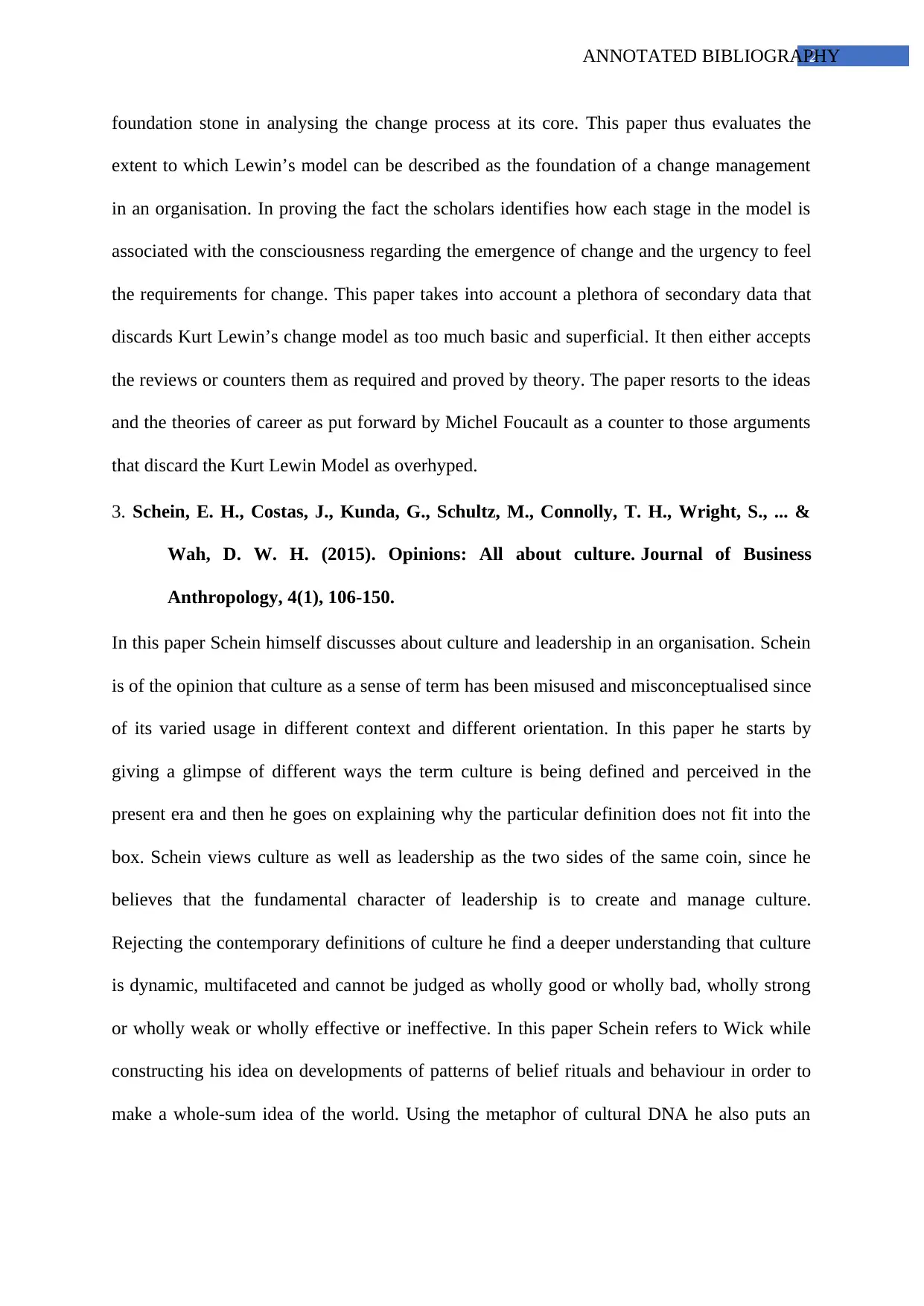
2ANNOTATED BIBLIOGRAPHY
foundation stone in analysing the change process at its core. This paper thus evaluates the
extent to which Lewin’s model can be described as the foundation of a change management
in an organisation. In proving the fact the scholars identifies how each stage in the model is
associated with the consciousness regarding the emergence of change and the urgency to feel
the requirements for change. This paper takes into account a plethora of secondary data that
discards Kurt Lewin’s change model as too much basic and superficial. It then either accepts
the reviews or counters them as required and proved by theory. The paper resorts to the ideas
and the theories of career as put forward by Michel Foucault as a counter to those arguments
that discard the Kurt Lewin Model as overhyped.
3. Schein, E. H., Costas, J., Kunda, G., Schultz, M., Connolly, T. H., Wright, S., ... &
Wah, D. W. H. (2015). Opinions: All about culture. Journal of Business
Anthropology, 4(1), 106-150.
In this paper Schein himself discusses about culture and leadership in an organisation. Schein
is of the opinion that culture as a sense of term has been misused and misconceptualised since
of its varied usage in different context and different orientation. In this paper he starts by
giving a glimpse of different ways the term culture is being defined and perceived in the
present era and then he goes on explaining why the particular definition does not fit into the
box. Schein views culture as well as leadership as the two sides of the same coin, since he
believes that the fundamental character of leadership is to create and manage culture.
Rejecting the contemporary definitions of culture he find a deeper understanding that culture
is dynamic, multifaceted and cannot be judged as wholly good or wholly bad, wholly strong
or wholly weak or wholly effective or ineffective. In this paper Schein refers to Wick while
constructing his idea on developments of patterns of belief rituals and behaviour in order to
make a whole-sum idea of the world. Using the metaphor of cultural DNA he also puts an
foundation stone in analysing the change process at its core. This paper thus evaluates the
extent to which Lewin’s model can be described as the foundation of a change management
in an organisation. In proving the fact the scholars identifies how each stage in the model is
associated with the consciousness regarding the emergence of change and the urgency to feel
the requirements for change. This paper takes into account a plethora of secondary data that
discards Kurt Lewin’s change model as too much basic and superficial. It then either accepts
the reviews or counters them as required and proved by theory. The paper resorts to the ideas
and the theories of career as put forward by Michel Foucault as a counter to those arguments
that discard the Kurt Lewin Model as overhyped.
3. Schein, E. H., Costas, J., Kunda, G., Schultz, M., Connolly, T. H., Wright, S., ... &
Wah, D. W. H. (2015). Opinions: All about culture. Journal of Business
Anthropology, 4(1), 106-150.
In this paper Schein himself discusses about culture and leadership in an organisation. Schein
is of the opinion that culture as a sense of term has been misused and misconceptualised since
of its varied usage in different context and different orientation. In this paper he starts by
giving a glimpse of different ways the term culture is being defined and perceived in the
present era and then he goes on explaining why the particular definition does not fit into the
box. Schein views culture as well as leadership as the two sides of the same coin, since he
believes that the fundamental character of leadership is to create and manage culture.
Rejecting the contemporary definitions of culture he find a deeper understanding that culture
is dynamic, multifaceted and cannot be judged as wholly good or wholly bad, wholly strong
or wholly weak or wholly effective or ineffective. In this paper Schein refers to Wick while
constructing his idea on developments of patterns of belief rituals and behaviour in order to
make a whole-sum idea of the world. Using the metaphor of cultural DNA he also puts an
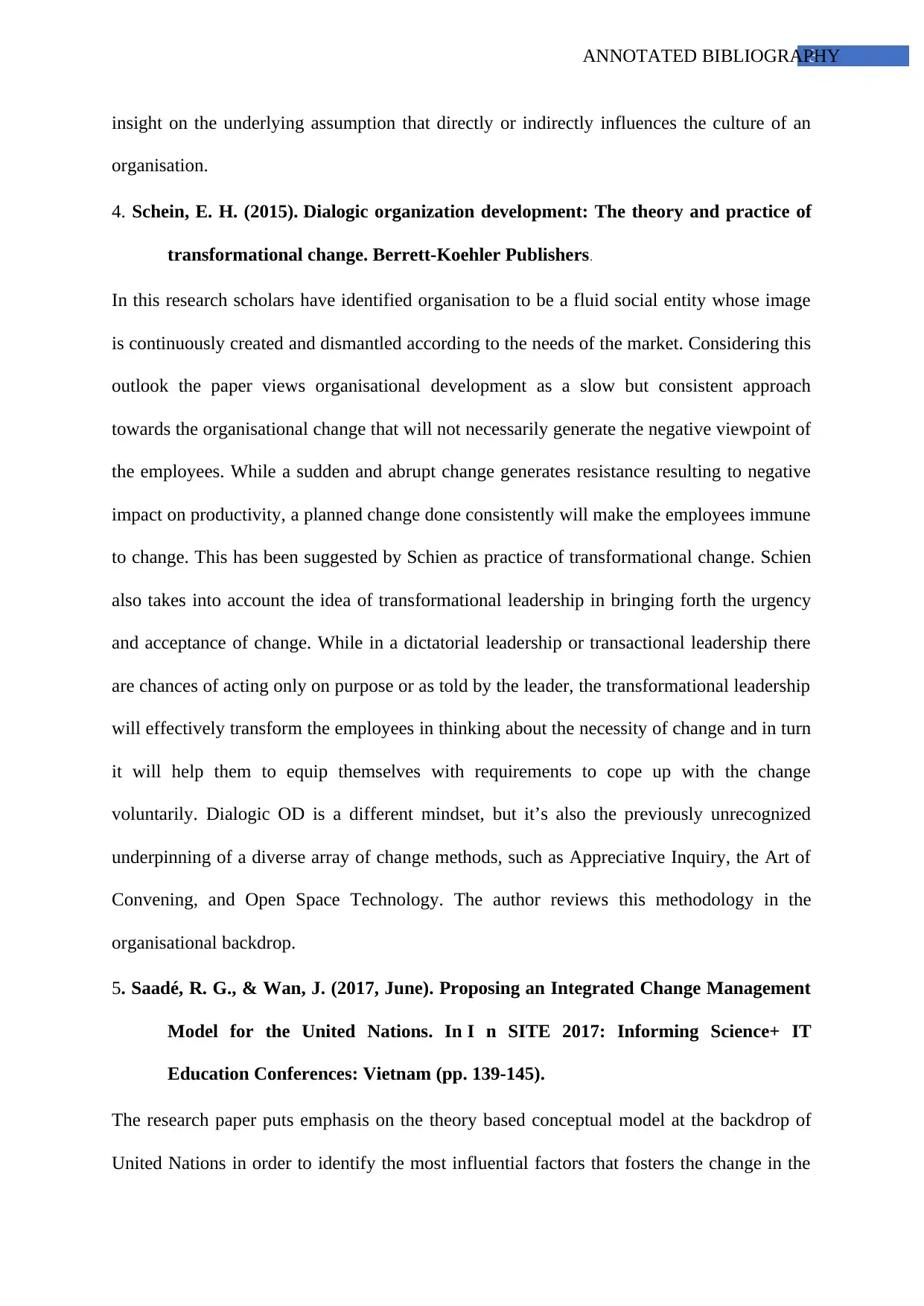
3ANNOTATED BIBLIOGRAPHY
insight on the underlying assumption that directly or indirectly influences the culture of an
organisation.
4. Schein, E. H. (2015). Dialogic organization development: The theory and practice of
transformational change. Berrett-Koehler Publishers.
In this research scholars have identified organisation to be a fluid social entity whose image
is continuously created and dismantled according to the needs of the market. Considering this
outlook the paper views organisational development as a slow but consistent approach
towards the organisational change that will not necessarily generate the negative viewpoint of
the employees. While a sudden and abrupt change generates resistance resulting to negative
impact on productivity, a planned change done consistently will make the employees immune
to change. This has been suggested by Schien as practice of transformational change. Schien
also takes into account the idea of transformational leadership in bringing forth the urgency
and acceptance of change. While in a dictatorial leadership or transactional leadership there
are chances of acting only on purpose or as told by the leader, the transformational leadership
will effectively transform the employees in thinking about the necessity of change and in turn
it will help them to equip themselves with requirements to cope up with the change
voluntarily. Dialogic OD is a different mindset, but it’s also the previously unrecognized
underpinning of a diverse array of change methods, such as Appreciative Inquiry, the Art of
Convening, and Open Space Technology. The author reviews this methodology in the
organisational backdrop.
5. Saadé, R. G., & Wan, J. (2017, June). Proposing an Integrated Change Management
Model for the United Nations. In I n SITE 2017: Informing Science+ IT
Education Conferences: Vietnam (pp. 139-145).
The research paper puts emphasis on the theory based conceptual model at the backdrop of
United Nations in order to identify the most influential factors that fosters the change in the
insight on the underlying assumption that directly or indirectly influences the culture of an
organisation.
4. Schein, E. H. (2015). Dialogic organization development: The theory and practice of
transformational change. Berrett-Koehler Publishers.
In this research scholars have identified organisation to be a fluid social entity whose image
is continuously created and dismantled according to the needs of the market. Considering this
outlook the paper views organisational development as a slow but consistent approach
towards the organisational change that will not necessarily generate the negative viewpoint of
the employees. While a sudden and abrupt change generates resistance resulting to negative
impact on productivity, a planned change done consistently will make the employees immune
to change. This has been suggested by Schien as practice of transformational change. Schien
also takes into account the idea of transformational leadership in bringing forth the urgency
and acceptance of change. While in a dictatorial leadership or transactional leadership there
are chances of acting only on purpose or as told by the leader, the transformational leadership
will effectively transform the employees in thinking about the necessity of change and in turn
it will help them to equip themselves with requirements to cope up with the change
voluntarily. Dialogic OD is a different mindset, but it’s also the previously unrecognized
underpinning of a diverse array of change methods, such as Appreciative Inquiry, the Art of
Convening, and Open Space Technology. The author reviews this methodology in the
organisational backdrop.
5. Saadé, R. G., & Wan, J. (2017, June). Proposing an Integrated Change Management
Model for the United Nations. In I n SITE 2017: Informing Science+ IT
Education Conferences: Vietnam (pp. 139-145).
The research paper puts emphasis on the theory based conceptual model at the backdrop of
United Nations in order to identify the most influential factors that fosters the change in the
Secure Best Marks with AI Grader
Need help grading? Try our AI Grader for instant feedback on your assignments.
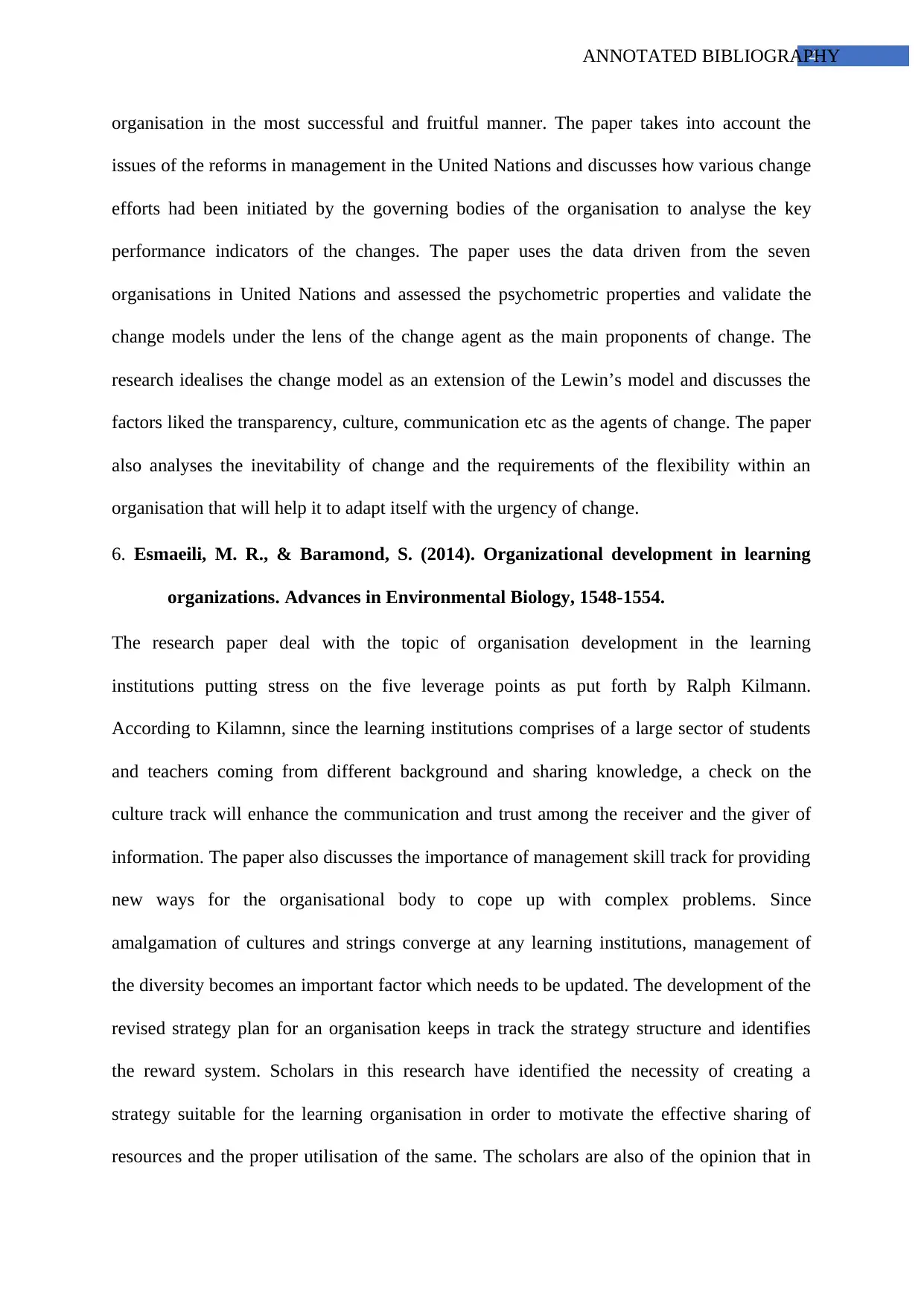
4ANNOTATED BIBLIOGRAPHY
organisation in the most successful and fruitful manner. The paper takes into account the
issues of the reforms in management in the United Nations and discusses how various change
efforts had been initiated by the governing bodies of the organisation to analyse the key
performance indicators of the changes. The paper uses the data driven from the seven
organisations in United Nations and assessed the psychometric properties and validate the
change models under the lens of the change agent as the main proponents of change. The
research idealises the change model as an extension of the Lewin’s model and discusses the
factors liked the transparency, culture, communication etc as the agents of change. The paper
also analyses the inevitability of change and the requirements of the flexibility within an
organisation that will help it to adapt itself with the urgency of change.
6. Esmaeili, M. R., & Baramond, S. (2014). Organizational development in learning
organizations. Advances in Environmental Biology, 1548-1554.
The research paper deal with the topic of organisation development in the learning
institutions putting stress on the five leverage points as put forth by Ralph Kilmann.
According to Kilamnn, since the learning institutions comprises of a large sector of students
and teachers coming from different background and sharing knowledge, a check on the
culture track will enhance the communication and trust among the receiver and the giver of
information. The paper also discusses the importance of management skill track for providing
new ways for the organisational body to cope up with complex problems. Since
amalgamation of cultures and strings converge at any learning institutions, management of
the diversity becomes an important factor which needs to be updated. The development of the
revised strategy plan for an organisation keeps in track the strategy structure and identifies
the reward system. Scholars in this research have identified the necessity of creating a
strategy suitable for the learning organisation in order to motivate the effective sharing of
resources and the proper utilisation of the same. The scholars are also of the opinion that in
organisation in the most successful and fruitful manner. The paper takes into account the
issues of the reforms in management in the United Nations and discusses how various change
efforts had been initiated by the governing bodies of the organisation to analyse the key
performance indicators of the changes. The paper uses the data driven from the seven
organisations in United Nations and assessed the psychometric properties and validate the
change models under the lens of the change agent as the main proponents of change. The
research idealises the change model as an extension of the Lewin’s model and discusses the
factors liked the transparency, culture, communication etc as the agents of change. The paper
also analyses the inevitability of change and the requirements of the flexibility within an
organisation that will help it to adapt itself with the urgency of change.
6. Esmaeili, M. R., & Baramond, S. (2014). Organizational development in learning
organizations. Advances in Environmental Biology, 1548-1554.
The research paper deal with the topic of organisation development in the learning
institutions putting stress on the five leverage points as put forth by Ralph Kilmann.
According to Kilamnn, since the learning institutions comprises of a large sector of students
and teachers coming from different background and sharing knowledge, a check on the
culture track will enhance the communication and trust among the receiver and the giver of
information. The paper also discusses the importance of management skill track for providing
new ways for the organisational body to cope up with complex problems. Since
amalgamation of cultures and strings converge at any learning institutions, management of
the diversity becomes an important factor which needs to be updated. The development of the
revised strategy plan for an organisation keeps in track the strategy structure and identifies
the reward system. Scholars in this research have identified the necessity of creating a
strategy suitable for the learning organisation in order to motivate the effective sharing of
resources and the proper utilisation of the same. The scholars are also of the opinion that in
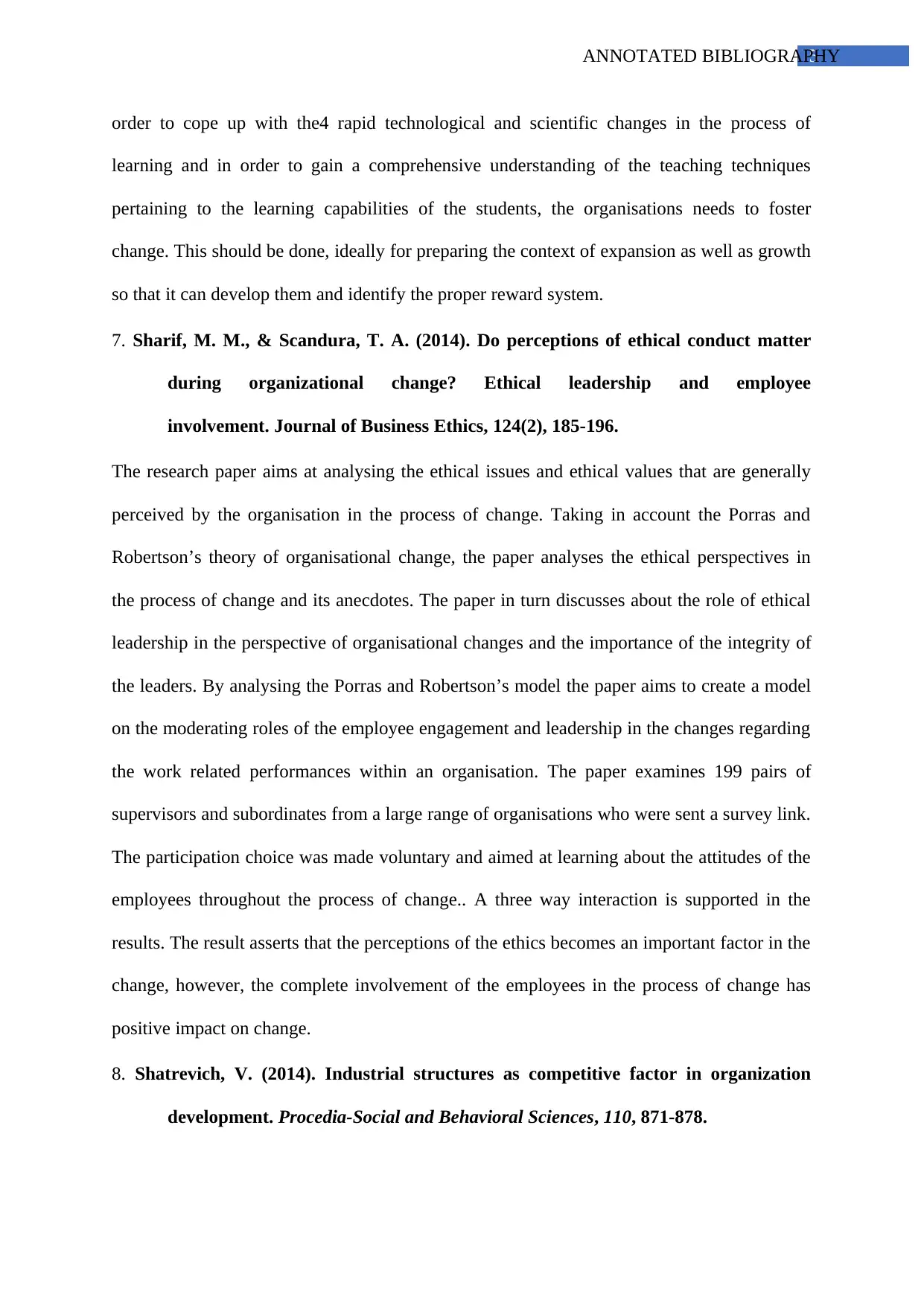
5ANNOTATED BIBLIOGRAPHY
order to cope up with the4 rapid technological and scientific changes in the process of
learning and in order to gain a comprehensive understanding of the teaching techniques
pertaining to the learning capabilities of the students, the organisations needs to foster
change. This should be done, ideally for preparing the context of expansion as well as growth
so that it can develop them and identify the proper reward system.
7. Sharif, M. M., & Scandura, T. A. (2014). Do perceptions of ethical conduct matter
during organizational change? Ethical leadership and employee
involvement. Journal of Business Ethics, 124(2), 185-196.
The research paper aims at analysing the ethical issues and ethical values that are generally
perceived by the organisation in the process of change. Taking in account the Porras and
Robertson’s theory of organisational change, the paper analyses the ethical perspectives in
the process of change and its anecdotes. The paper in turn discusses about the role of ethical
leadership in the perspective of organisational changes and the importance of the integrity of
the leaders. By analysing the Porras and Robertson’s model the paper aims to create a model
on the moderating roles of the employee engagement and leadership in the changes regarding
the work related performances within an organisation. The paper examines 199 pairs of
supervisors and subordinates from a large range of organisations who were sent a survey link.
The participation choice was made voluntary and aimed at learning about the attitudes of the
employees throughout the process of change.. A three way interaction is supported in the
results. The result asserts that the perceptions of the ethics becomes an important factor in the
change, however, the complete involvement of the employees in the process of change has
positive impact on change.
8. Shatrevich, V. (2014). Industrial structures as competitive factor in organization
development. Procedia-Social and Behavioral Sciences, 110, 871-878.
order to cope up with the4 rapid technological and scientific changes in the process of
learning and in order to gain a comprehensive understanding of the teaching techniques
pertaining to the learning capabilities of the students, the organisations needs to foster
change. This should be done, ideally for preparing the context of expansion as well as growth
so that it can develop them and identify the proper reward system.
7. Sharif, M. M., & Scandura, T. A. (2014). Do perceptions of ethical conduct matter
during organizational change? Ethical leadership and employee
involvement. Journal of Business Ethics, 124(2), 185-196.
The research paper aims at analysing the ethical issues and ethical values that are generally
perceived by the organisation in the process of change. Taking in account the Porras and
Robertson’s theory of organisational change, the paper analyses the ethical perspectives in
the process of change and its anecdotes. The paper in turn discusses about the role of ethical
leadership in the perspective of organisational changes and the importance of the integrity of
the leaders. By analysing the Porras and Robertson’s model the paper aims to create a model
on the moderating roles of the employee engagement and leadership in the changes regarding
the work related performances within an organisation. The paper examines 199 pairs of
supervisors and subordinates from a large range of organisations who were sent a survey link.
The participation choice was made voluntary and aimed at learning about the attitudes of the
employees throughout the process of change.. A three way interaction is supported in the
results. The result asserts that the perceptions of the ethics becomes an important factor in the
change, however, the complete involvement of the employees in the process of change has
positive impact on change.
8. Shatrevich, V. (2014). Industrial structures as competitive factor in organization
development. Procedia-Social and Behavioral Sciences, 110, 871-878.
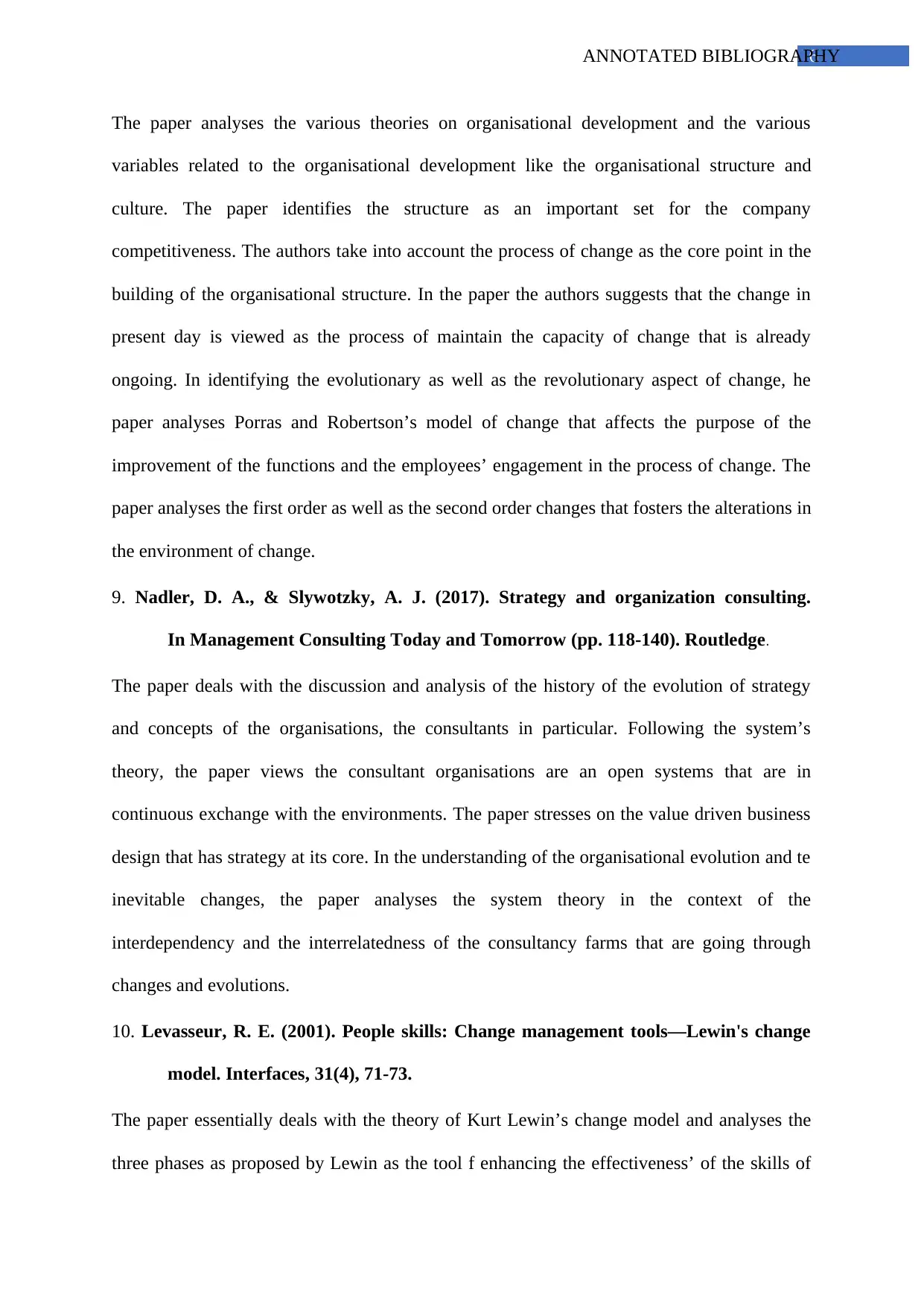
6ANNOTATED BIBLIOGRAPHY
The paper analyses the various theories on organisational development and the various
variables related to the organisational development like the organisational structure and
culture. The paper identifies the structure as an important set for the company
competitiveness. The authors take into account the process of change as the core point in the
building of the organisational structure. In the paper the authors suggests that the change in
present day is viewed as the process of maintain the capacity of change that is already
ongoing. In identifying the evolutionary as well as the revolutionary aspect of change, he
paper analyses Porras and Robertson’s model of change that affects the purpose of the
improvement of the functions and the employees’ engagement in the process of change. The
paper analyses the first order as well as the second order changes that fosters the alterations in
the environment of change.
9. Nadler, D. A., & Slywotzky, A. J. (2017). Strategy and organization consulting.
In Management Consulting Today and Tomorrow (pp. 118-140). Routledge.
The paper deals with the discussion and analysis of the history of the evolution of strategy
and concepts of the organisations, the consultants in particular. Following the system’s
theory, the paper views the consultant organisations are an open systems that are in
continuous exchange with the environments. The paper stresses on the value driven business
design that has strategy at its core. In the understanding of the organisational evolution and te
inevitable changes, the paper analyses the system theory in the context of the
interdependency and the interrelatedness of the consultancy farms that are going through
changes and evolutions.
10. Levasseur, R. E. (2001). People skills: Change management tools—Lewin's change
model. Interfaces, 31(4), 71-73.
The paper essentially deals with the theory of Kurt Lewin’s change model and analyses the
three phases as proposed by Lewin as the tool f enhancing the effectiveness’ of the skills of
The paper analyses the various theories on organisational development and the various
variables related to the organisational development like the organisational structure and
culture. The paper identifies the structure as an important set for the company
competitiveness. The authors take into account the process of change as the core point in the
building of the organisational structure. In the paper the authors suggests that the change in
present day is viewed as the process of maintain the capacity of change that is already
ongoing. In identifying the evolutionary as well as the revolutionary aspect of change, he
paper analyses Porras and Robertson’s model of change that affects the purpose of the
improvement of the functions and the employees’ engagement in the process of change. The
paper analyses the first order as well as the second order changes that fosters the alterations in
the environment of change.
9. Nadler, D. A., & Slywotzky, A. J. (2017). Strategy and organization consulting.
In Management Consulting Today and Tomorrow (pp. 118-140). Routledge.
The paper deals with the discussion and analysis of the history of the evolution of strategy
and concepts of the organisations, the consultants in particular. Following the system’s
theory, the paper views the consultant organisations are an open systems that are in
continuous exchange with the environments. The paper stresses on the value driven business
design that has strategy at its core. In the understanding of the organisational evolution and te
inevitable changes, the paper analyses the system theory in the context of the
interdependency and the interrelatedness of the consultancy farms that are going through
changes and evolutions.
10. Levasseur, R. E. (2001). People skills: Change management tools—Lewin's change
model. Interfaces, 31(4), 71-73.
The paper essentially deals with the theory of Kurt Lewin’s change model and analyses the
three phases as proposed by Lewin as the tool f enhancing the effectiveness’ of the skills of
Paraphrase This Document
Need a fresh take? Get an instant paraphrase of this document with our AI Paraphraser
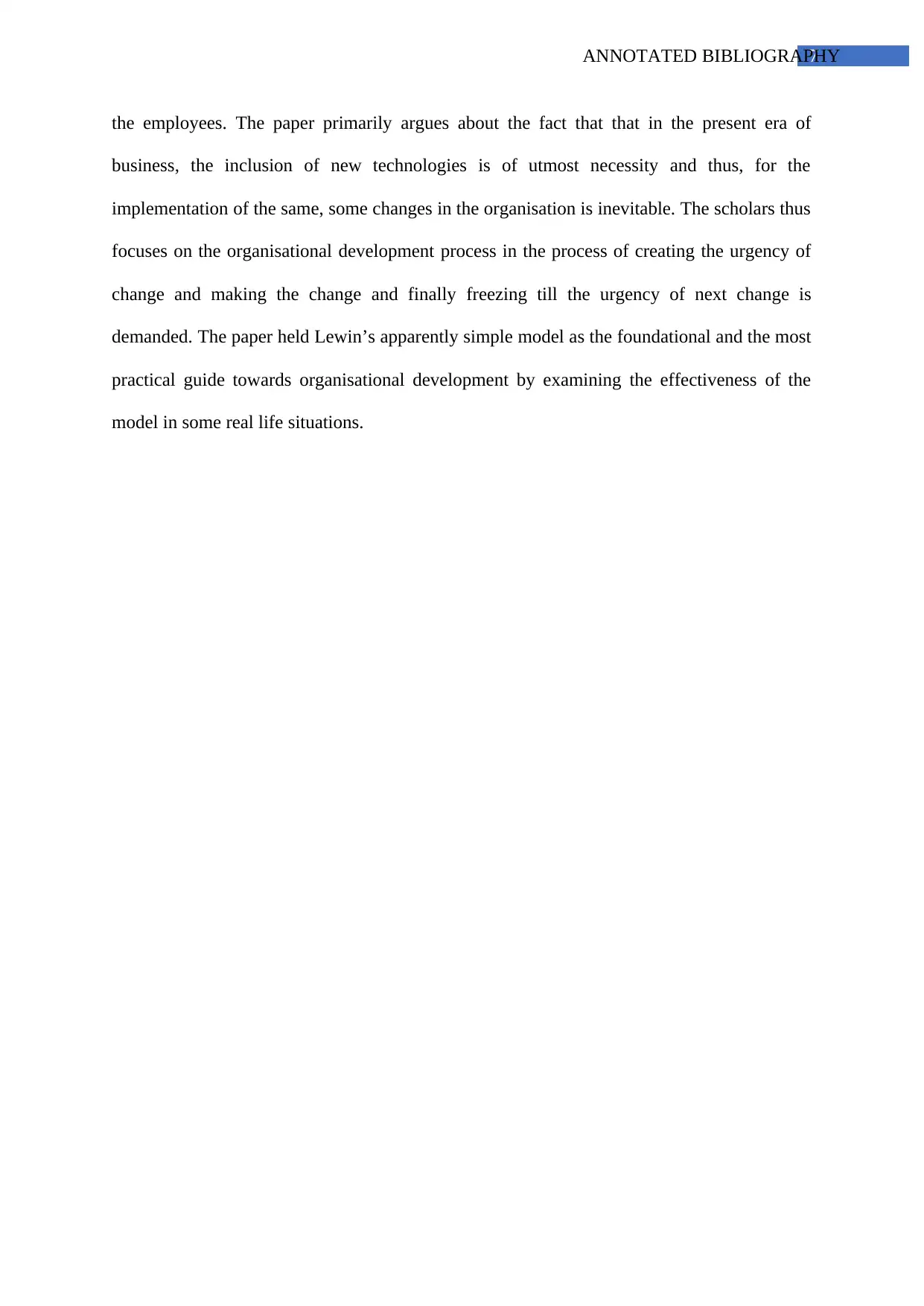
7ANNOTATED BIBLIOGRAPHY
the employees. The paper primarily argues about the fact that that in the present era of
business, the inclusion of new technologies is of utmost necessity and thus, for the
implementation of the same, some changes in the organisation is inevitable. The scholars thus
focuses on the organisational development process in the process of creating the urgency of
change and making the change and finally freezing till the urgency of next change is
demanded. The paper held Lewin’s apparently simple model as the foundational and the most
practical guide towards organisational development by examining the effectiveness of the
model in some real life situations.
the employees. The paper primarily argues about the fact that that in the present era of
business, the inclusion of new technologies is of utmost necessity and thus, for the
implementation of the same, some changes in the organisation is inevitable. The scholars thus
focuses on the organisational development process in the process of creating the urgency of
change and making the change and finally freezing till the urgency of next change is
demanded. The paper held Lewin’s apparently simple model as the foundational and the most
practical guide towards organisational development by examining the effectiveness of the
model in some real life situations.
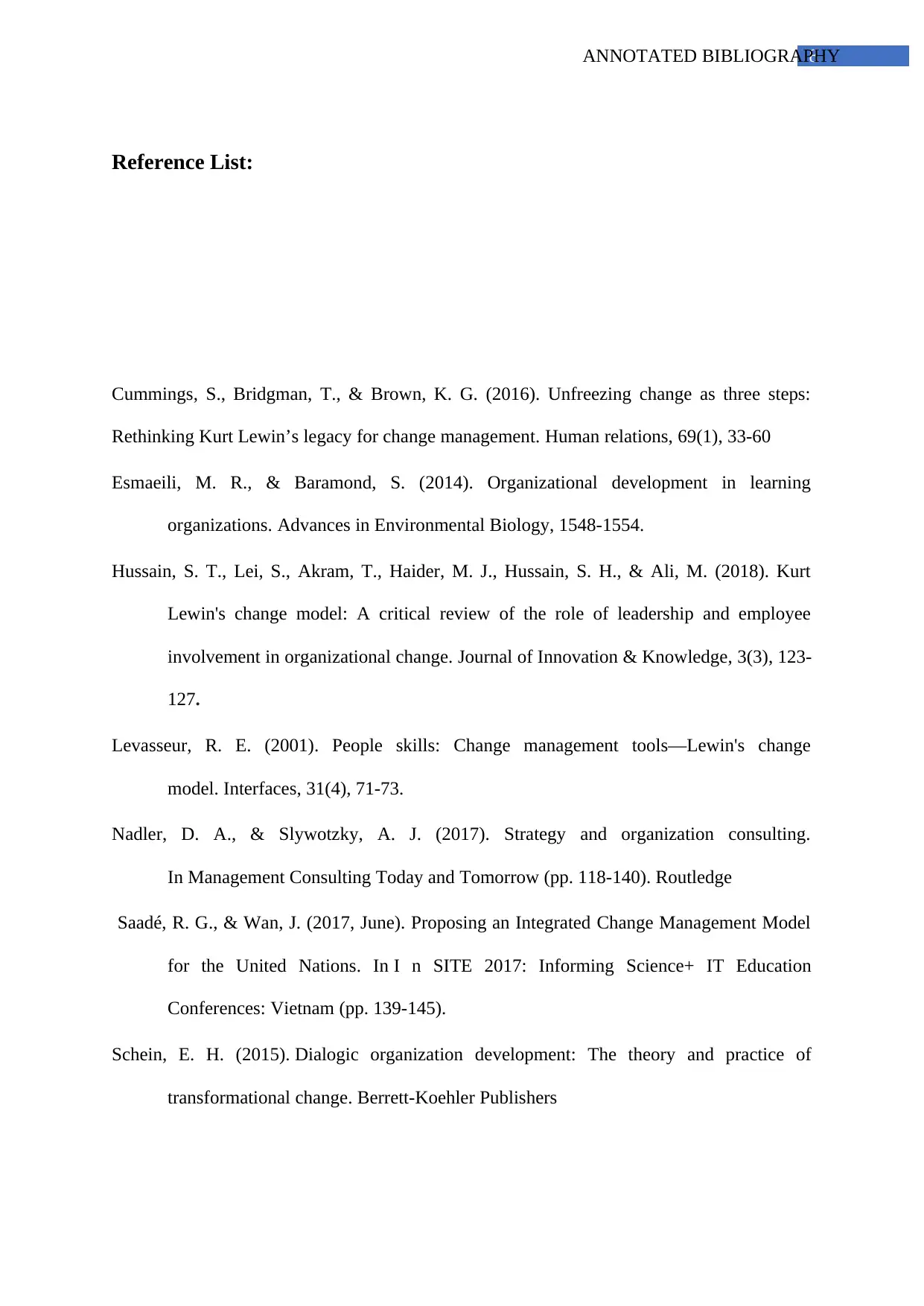
8ANNOTATED BIBLIOGRAPHY
Reference List:
Cummings, S., Bridgman, T., & Brown, K. G. (2016). Unfreezing change as three steps:
Rethinking Kurt Lewin’s legacy for change management. Human relations, 69(1), 33-60
Esmaeili, M. R., & Baramond, S. (2014). Organizational development in learning
organizations. Advances in Environmental Biology, 1548-1554.
Hussain, S. T., Lei, S., Akram, T., Haider, M. J., Hussain, S. H., & Ali, M. (2018). Kurt
Lewin's change model: A critical review of the role of leadership and employee
involvement in organizational change. Journal of Innovation & Knowledge, 3(3), 123-
127.
Levasseur, R. E. (2001). People skills: Change management tools—Lewin's change
model. Interfaces, 31(4), 71-73.
Nadler, D. A., & Slywotzky, A. J. (2017). Strategy and organization consulting.
In Management Consulting Today and Tomorrow (pp. 118-140). Routledge
Saadé, R. G., & Wan, J. (2017, June). Proposing an Integrated Change Management Model
for the United Nations. In I n SITE 2017: Informing Science+ IT Education
Conferences: Vietnam (pp. 139-145).
Schein, E. H. (2015). Dialogic organization development: The theory and practice of
transformational change. Berrett-Koehler Publishers
Reference List:
Cummings, S., Bridgman, T., & Brown, K. G. (2016). Unfreezing change as three steps:
Rethinking Kurt Lewin’s legacy for change management. Human relations, 69(1), 33-60
Esmaeili, M. R., & Baramond, S. (2014). Organizational development in learning
organizations. Advances in Environmental Biology, 1548-1554.
Hussain, S. T., Lei, S., Akram, T., Haider, M. J., Hussain, S. H., & Ali, M. (2018). Kurt
Lewin's change model: A critical review of the role of leadership and employee
involvement in organizational change. Journal of Innovation & Knowledge, 3(3), 123-
127.
Levasseur, R. E. (2001). People skills: Change management tools—Lewin's change
model. Interfaces, 31(4), 71-73.
Nadler, D. A., & Slywotzky, A. J. (2017). Strategy and organization consulting.
In Management Consulting Today and Tomorrow (pp. 118-140). Routledge
Saadé, R. G., & Wan, J. (2017, June). Proposing an Integrated Change Management Model
for the United Nations. In I n SITE 2017: Informing Science+ IT Education
Conferences: Vietnam (pp. 139-145).
Schein, E. H. (2015). Dialogic organization development: The theory and practice of
transformational change. Berrett-Koehler Publishers
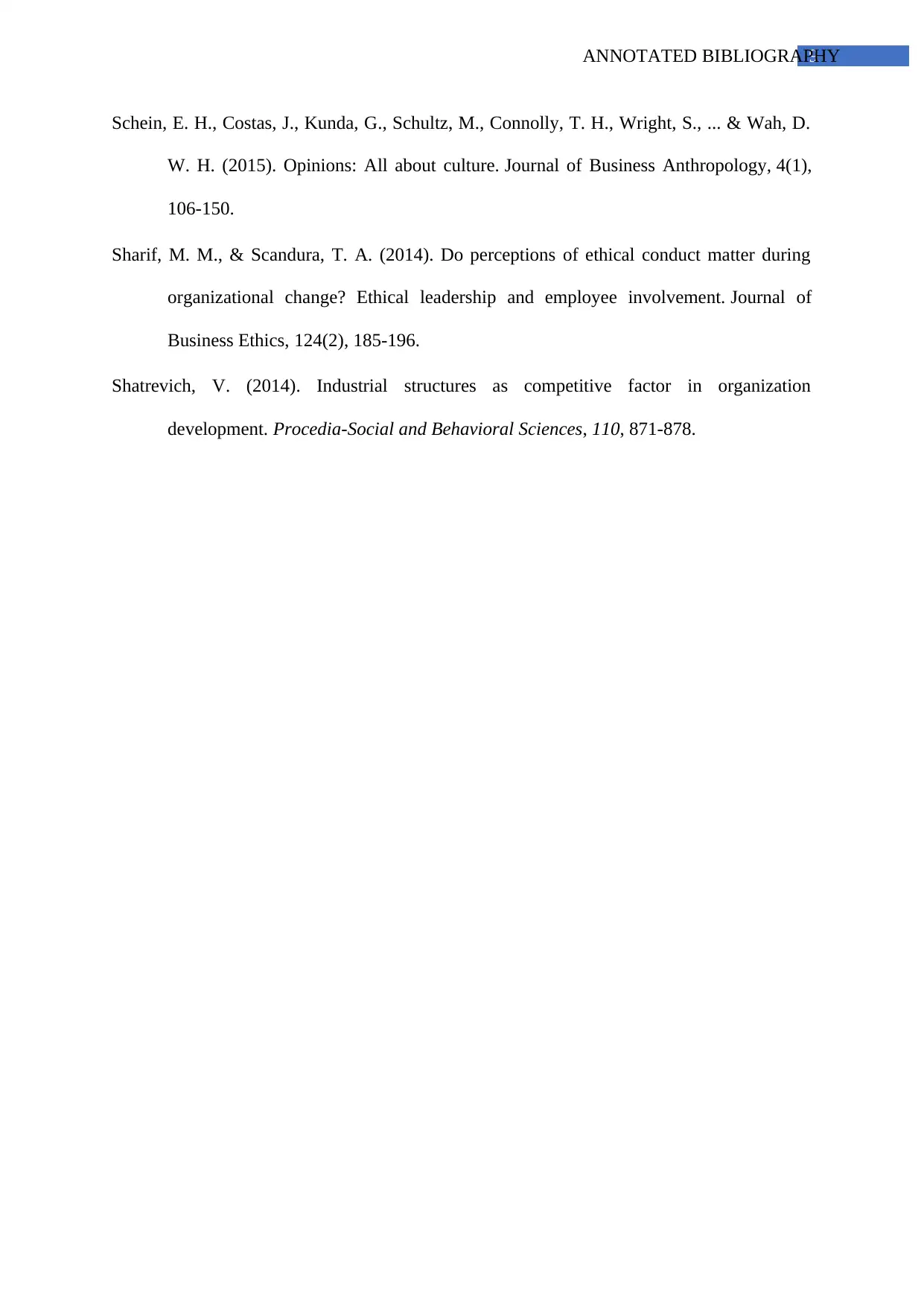
9ANNOTATED BIBLIOGRAPHY
Schein, E. H., Costas, J., Kunda, G., Schultz, M., Connolly, T. H., Wright, S., ... & Wah, D.
W. H. (2015). Opinions: All about culture. Journal of Business Anthropology, 4(1),
106-150.
Sharif, M. M., & Scandura, T. A. (2014). Do perceptions of ethical conduct matter during
organizational change? Ethical leadership and employee involvement. Journal of
Business Ethics, 124(2), 185-196.
Shatrevich, V. (2014). Industrial structures as competitive factor in organization
development. Procedia-Social and Behavioral Sciences, 110, 871-878.
Schein, E. H., Costas, J., Kunda, G., Schultz, M., Connolly, T. H., Wright, S., ... & Wah, D.
W. H. (2015). Opinions: All about culture. Journal of Business Anthropology, 4(1),
106-150.
Sharif, M. M., & Scandura, T. A. (2014). Do perceptions of ethical conduct matter during
organizational change? Ethical leadership and employee involvement. Journal of
Business Ethics, 124(2), 185-196.
Shatrevich, V. (2014). Industrial structures as competitive factor in organization
development. Procedia-Social and Behavioral Sciences, 110, 871-878.
1 out of 10
Related Documents
Your All-in-One AI-Powered Toolkit for Academic Success.
+13062052269
info@desklib.com
Available 24*7 on WhatsApp / Email
![[object Object]](/_next/static/media/star-bottom.7253800d.svg)
Unlock your academic potential
© 2024 | Zucol Services PVT LTD | All rights reserved.





